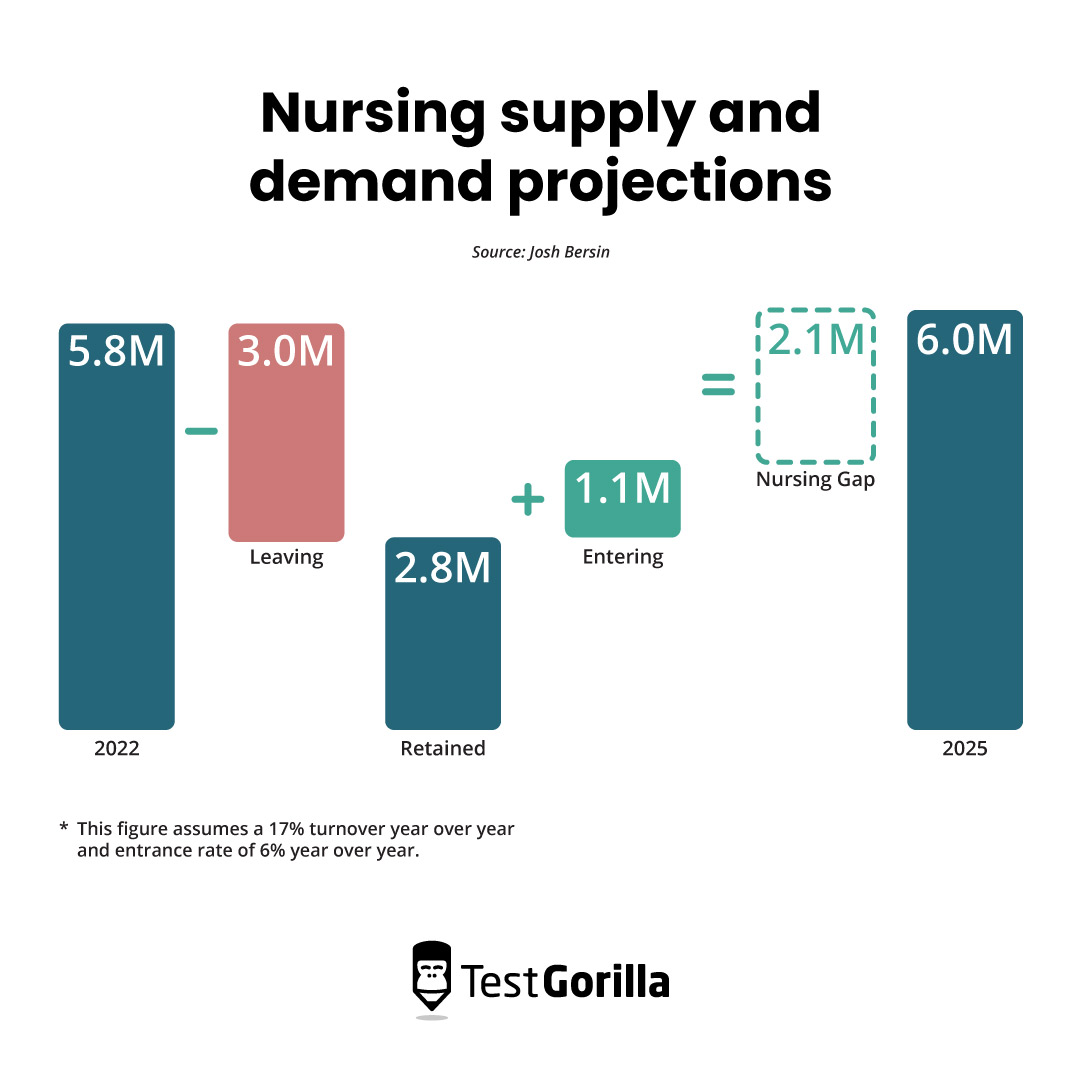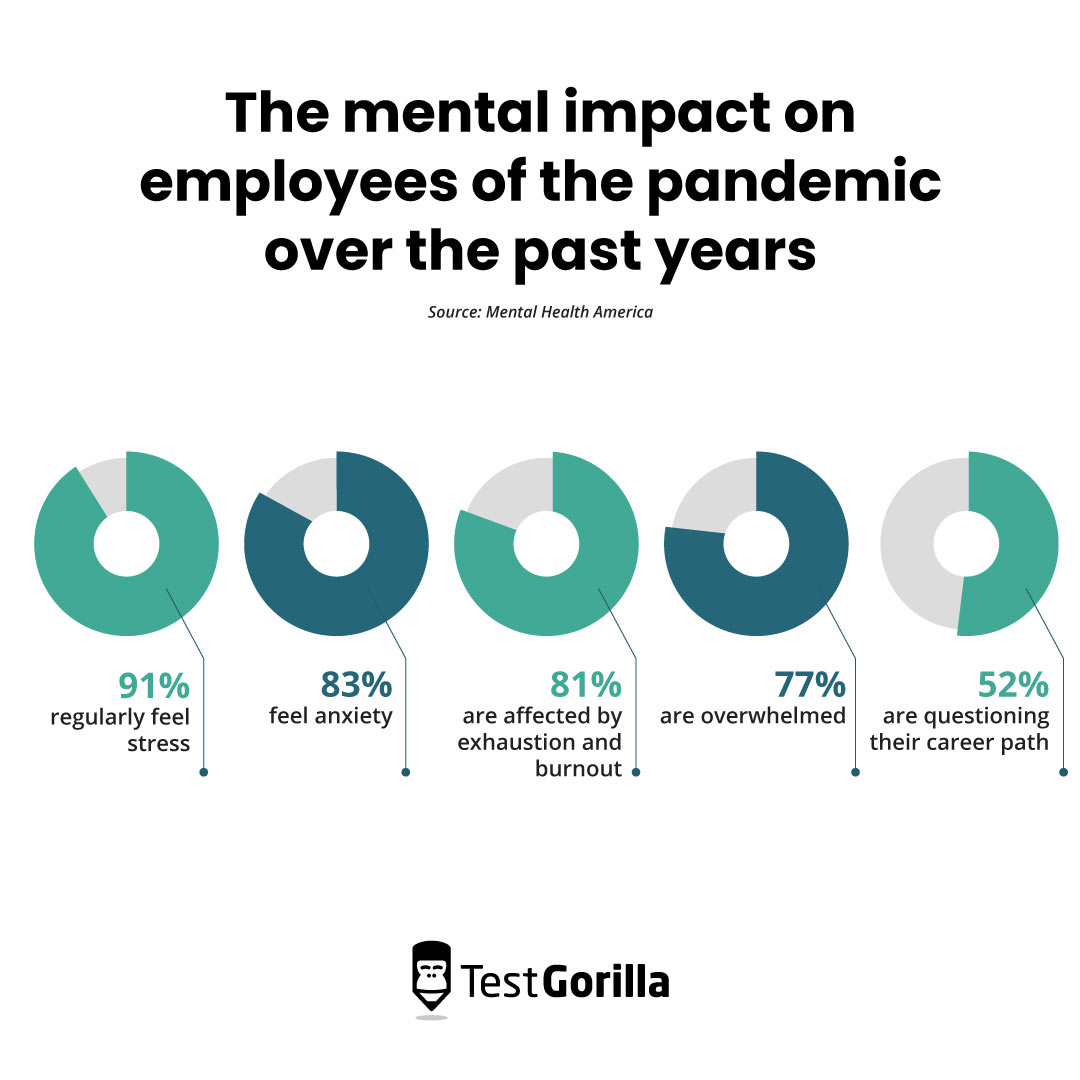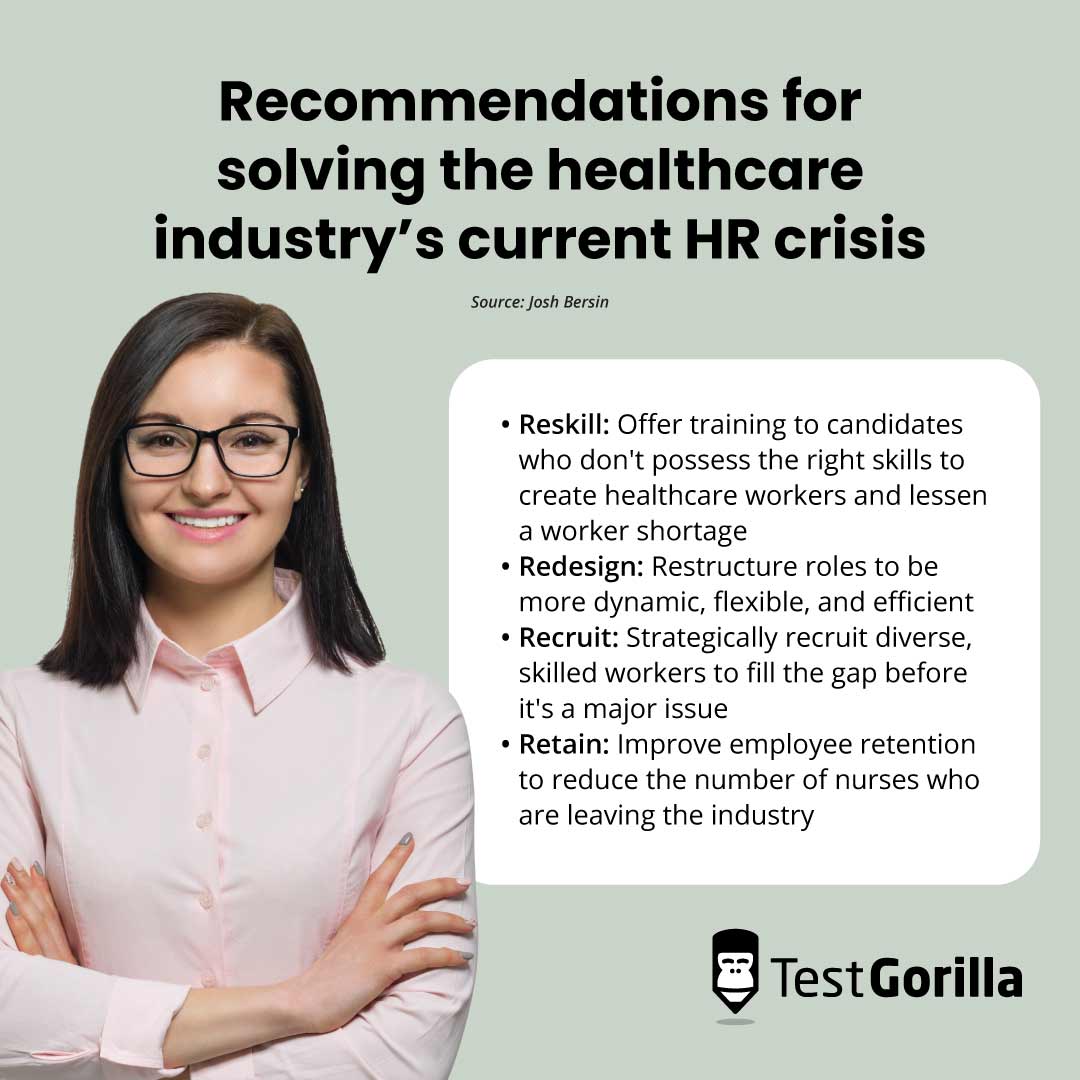Skills-based hiring in the healthcare industry
The healthcare industry is one of the largest in the US. The market size was valued at $359.2bn in 2022 and is projected to reach $781.5bn by 2030.[1]
This massive industry is currently facing a massive talent gap. Thousands of healthcare workers are leaving the industry, and too few are coming in. This means the healthcare sector needs to attract talent, stay competitive, improve working conditions, and retain top employees.
It’s certainly a tall order, but there’s a solid solution to each of these issues.
Let’s take a look at the current state of the healthcare industry and how skills-based hiring helps fill talent gaps, hire better candidates, and retain workers.
Table of contents
What are the struggles in healthcare recruiting?
It shouldn’t come as a surprise that the healthcare industry is facing immense adversity following the past few years.
It seems like it’s been one unprecedented event after another, including the Great Reshuffle and the Covid-19 pandemic, and the impact they’ve had on the healthcare sector has been significant.
1. Talent and skills shortage
A global skills shortage is currently sweeping the working world, but the effect it’s having on the healthcare sector is startling. Recent research has shown US healthcare organizations will face a 2.1m gap in nursing roles alone by 2025.
According to PR Newswire, the traditional approach of recruiting, training, and retaining employees is insufficient to resolve the projected shortage. The situation is unfortunately similar in other areas of the world.
2. The nursing gap
The UK is facing a nursing gap, with more than one million healthcare workers needed by 2030. Australia’s nurses are also in high demand, and many nurses are vacating their positions or considering quitting.
There are many reasons for these nursing shortages, but here are the top ones:
Many nurses from older generations are retiring
New nursing positions are developing every day due to new technology
The pandemic has left countless nurses stressed and ready to pursue new opportunities
This last point is crucial. The stress and burnout faced by healthcare workers have not only affected the skills shortage, but they’re problems in their own right. We’ll discuss this next.
3. DE&I
There's a lack of diversity in healthcare workforces: For example, only 14% of hospital board members and 9% of CEOs are minorities, according to the most recent study by the American Hospital Association’s Institute for Diversity and Health Equity.
Another study shows that 22.2% of Black adults reported being of the same race as their healthcare providers compared to 73.8% of White adults.
This is crucial because if diverse patients see themselves within the healthcare workforce, they are more likely to trust their healthcare provider. They are also better able to communicate their health problems, and more likely to understand and follow their prescribed treatment.
Ultimately, improving DE&I within the healthcare sector will lead to better, more satisfying healthcare services.
4. Burnout and stress from the pandemic
The pandemic was hard on us all, but it was especially impactful on healthcare workers. A recent survey on the mental impact of the pandemic asked 5,000 frontline healthcare workers how the past years have affected their health.
Here are the startling results:
91% regularly feel stress
83% feel anxiety
81% are affected by exhaustion and burnout
77% are overwhelmed
52% are questioning their career path
It also found that healthcare professionals have seen an increase in headaches, stomachaches, and trouble sleeping.
The pandemic put sudden, immense pressure on an industry that’s already demanding and difficult. The turnover rate in the healthcare sector is higher than in many other industries and has a high prevalence of employee burnout.[2] For more insights, read our full guide on managing and preventing employee burnout.
Experts believe the simplest way to solve these issues is to redesign work, job roles, and hiring processes.[3] Thousands of nursing jobs can be streamlined through restructuring roles, upskilling, and reskilling.
It’s also imperative to promote a healthier culture that provides stressed, burnt-out workers with a safe atmosphere. Traditional approaches to work aren’t going to solve these problems. However, skills-based practices can.
How can skills-based hiring practices help?
Skills-based organizations put skills first. Skills are the foundation for hiring choices, role structure, work decisions, employee growth, and compensation.
Here are a few key principles of skills-based practices:
A focus on skills over connection, pedigree, work history, or education
A focus on upskilling, reskilling, and continuous improvement
Less rigid roles and people doing responsibilities they’re good at, regardless of “role”
A more inclusive atmosphere and culture focused on people’s capabilities
This approach enables skills-based organizations to be more responsive and agile than other company structures. For example, employees with fluid job roles are able to flex to multiple tasks when sudden work demands emerge.
Adaptability like this is imperative in the current landscape. Events like the pandemic and the Great Discontent hit the healthcare industry hard, and better agility helps organizations respond to sudden change with more ease. For a deep dive into this topic, read our article on skills-based organizations and agility.
The benefits of skills-based hiring
The benefits of skills-based hiring, which are well documented in our latest State of Skills-Based Hiring Report, could help with many of the issues faced in the healthcare industry. According to our data:
89% of employers who adopt skills-based hiring improve retention rates
84% of employers who adopt skills-based hiring improve diversity
75% of Black employees gained access to employment opportunities through skills-based hiring
73% of Asian and Arab employees gained access to employment opportunities through skills-based hiring
Employers hired via skills-based hiring are happier in their roles
The State of Skills-Based Hiring 2024
Read TestGorilla's annual report to discover why over 81% of companies are choosing to adopt skills-based hiring methods in 2024.
Are skills-based practices the answer to the healthcare industry’s struggles?
Skills-based hiring practices can alleviate the pressure on the healthcare industry by optimizing its recruitment processes
According to TestGorilla’s State of Skills-Based Hiring report, 81% of organizations use skills-based practices in 2024. In 2022, 9.4% of the companies using skills-based hiring were from the healthcare sector.
A report from Josh Bersin recommends this model for solving the healthcare industry’s current HR crisis:
Reskill. Offer training to candidates who don’t possess the right skills to create healthcare workers and lessen a worker shortage
Redesign. Restructure roles to be more dynamic, flexible, and efficient
Recruit. Strategically recruit diverse, skilled workers to fill the gap before it’s a major issue
Retain. Improve employee retention to reduce the number of nurses who are leaving the industry[3]
Skills-based practices help you hit on all of these points. For example, “reskill” can be linked to skills-based practices’ emphasis on upskilling and reskilling. “Retain” relates to skills-based hiring’s track record with increased retention.
That’s just a quick example — we’ll expand on these in the next section.
6 skills-based strategies to improve hiring in the healthcare industry
Let’s take a look at some proven tips for how skills-based practices can help alleviate the healthcare industry's problems with hiring and retention.
1. Widen the talent pool
One of the best methods to end a talent shortage is to widen your talent pool to include more candidates. There are many ways to do this: For example, improving a healthcare aide job description by removing unnecessary degree requirements might more candidates to apply.
One study found that within the healthcare and social assistance industry, 92 occupations representing 621,000 jobs are at risk of degree inflation. This report also discloses that 64% of employers within the industry acknowledged they reject job candidates who have the skills and experience required because they don’t have a four-year degree.[4]
Skills-based hiring helps remove this barrier (and more) by reducing reliance on education, work history, and years of experience. It also reduces unconscious bias.
This is exactly how the UK’s National Health Service (NHS) is alleviating its own skills shortage. A stand-out example is Rabiu Ala Harana, a healthcare support worker who previously didn’t have enough on his resume to get hired in his current role.
Rabiu had a natural ability to help others and a passion for healthcare, but his background in human resources was preventing him from pursuing his dream job.[5] Skills-based hiring removed these barriers so that Rabiu could find meaningful work.
2. Focus on skills to increase retention
Much of the projected nursing gap in the next two years is due to the three million nurses leaving the industry. Of course, some of these are older workers who will be retiring. But what about the rest?
Stressed, burnt-out nurses are considering leaving their organizations, and a solid retention strategy is needed to stop this. Enter skills-based hiring: 89% of employers using skills-based hiring increase their retention rates.
Why? Well, assessing and verifying the skills needed to complete a role ensures the candidate is a good match for the job. If the employee’s skill set matches the position, it’s much more likely they will succeed and stay in their new role and be retained.
Having the right skills to complete your work also lowers stress and burnout, all while boosting employee happiness, too.
Recommended reading:
3. Implement more training and upskilling
Training your healthcare workers is essential to solving both the current and projected issues in the healthcare industry. Upskilling and reskilling is a crucial strategy for attracting and retaining great talent. The desire for learning and development is in high demand, and for many workers, it’s a necessity.
Imagine that you attract a candidate who’s a suitable match but doesn’t possess 100% of the requirements. You can then upskill them in the necessary fields to nurture the ideal employee for the position. For instance, if you’re hiring a recreational therapist who’s empathetic and organized but needs more activity ideas – they can be taught different strategies and approaches.
A great real-life example of upskilling and reskilling in the healthcare sector is Sam Saucedo Hernandez, a STARs worker.
Sam was able to secure an excellent job and support her children, all thanks to learning and development opportunities. She underwent a job training program with JVS, a program that helps people build skills and find reliable career paths, particularly for diverse and disadvantaged candidates.
Sam entered the field as a medical administrative assistant, but through further development, she’s currently in the audiology department.[6] To read Sam’s story and more, check out our blog on skills-based success.
4. Create more flexible job roles
“Redesign” is one of the above-mentioned methods for solving the current talent crisis. This means restructuring current roles in healthcare organizations to be more fluid and efficient.
Traditional work practices have a rigid view of job roles, which isn’t helping the need for this redesign. On the other hand, skills-based organizations have a forward-thinking approach to job roles and responsibilities. They nurture adaptable employees with multiple skill sets who are able to complete various different tasks.
These organizations view jobs as “goals” and “outcomes to be achieved,” and whoever has the right capabilities can get the job done. In a skills-based organization, a bedside nurse with the right training could occasionally fulfill the responsibilities of an emergency medical technician when needed.
To learn more about this new work structure, read our article on the changing role of managers in skills-first organizations.
5. Create a positive, inclusive culture
A positive culture is a key element in your employee retention strategy when so many healthcare workers are stressed, burnt out, and experiencing anxiety. A recent study by MIT Sloan found toxic culture was the top driver of attrition, ranking 10.4 times higher than compensation issues.
Healthcare workers already have to deal with a lot of stress and negativity at work. A 2022 study found an average of two nurses are assaulted every hour, with the “majority of aggressors” being patients.[7]
This means the last thing these people need is a biting comment from a colleague or a manager yelling at them. They need a supportive company that prioritizes psychological safety.
Toxic, negative conditions are driving countless workers from their jobs, and skills-based practices encourage a positive, inclusive culture.
Inclusivity is woven into the fabric of skills-based practices. They put an emphasis on equality, fairness, and skills over pedigree and connections. This refocuses on what an employee does and how well they do it, not on personal details of who they are and where they’re from.
6. Hire for soft skills, culture, and personality
Healthcare isn’t just experiencing a talent shortage; it’s also experiencing a soft skills shortage. Medical fields require keen technical skills, but their reliance on soft skills cannot be downplayed.
Here are a few crucial soft skills the industry needs right now:
Time management
Communication
Leadership
Compassion and empathy
These skills are in high demand, and skills-based hiring can help you find them. Skills tests can help you assess a candidate’s soft skills objectively and accurately - like TestGorilla's Communication skills test and Time management test.
To learn how to use skills tests to hire empathetic, communicative health care workers, check out this how to hire a midwife example.
You can also nurture your organization’s beliefs and goals by using our Culture add test to align a candidate’s values to your company’s. This encourages a healthy culture and helps you hire more compassionate, empathetic employees.
Recommended reading:
44 nursing behavioral interview questions (+ answers to look for)
35 pharmacy technician interview questions (+ sample answers)
The future of hiring in the healthcare industry is skills-based
The healthcare industry is going through tough times right now: It’s no easy feat to recover from the pandemic and sort through a skills shortage.
Skills-based practices can help solve these critical issues. They attract more workers to close an incoming nursing gap, encourage more training and upskilling, and create a culture where workers feel safe.
For more on the topic of skills-based hiring and the healthcare industry, read our article on male inequality in HEAL jobs.
To evaluate a candidate on patient care and basic life support, use TestGorilla’s Health Care Aide test in your next pre-employment assessment. You can also check out our guides to hiring health care aides and home health care aides.
Sources
“Consumer Healthcare Market Size And Forecast”. (2022). Verified Market Research. Retrieved May 26, 2023. https://www.verifiedmarketresearch.com/product/consumer-healthcare-market/
“Burnout and Health Care Workforce Turnover”. (January 2019). National Library of Medicine. Retrieved May 26, 2023. https://www.ncbi.nlm.nih.gov/pmc/articles/PMC6342603/
Bersin, Josh. (September 14, 2022). “The Healthcare Industry Has A Talent Crisis: We Found The Cure.”. Josh Bersin. Retrieved May 26, 2023. https://joshbersin.com/2022/09/the-healthcare-industry-has-a-talent-crisis-we-found-the-cure/
“Dismissed by Degrees”. (October 2017). Harvard Business School. Retrieved May 26, 2023. https://gradsoflife.org/wp-content/uploads/2020/07/Dismissed-by-Degrees-10.26.17-1.pdf
McLellan, Allison. (February 21, 2023). “Skills-Based Hiring Case Study: The National Health Service”. Indeed for Employers. Retrieved May 26, 2023. https://www.indeed.com/lead/skills-based-hiring-case-study-the-national-health-service
“Samantha Hernandez – Healthcare”. (n.d.) Tear the Paper Ceiling. Retrieved May 26, 2023. https://www.tearthepaperceiling.org/stories/samantha-saucedo-hernandez-medical-practice-coordinator
Carbajal, Erica. (September 8th, 2022). “2 nurses assaulted every hour, Press Ganey analysis shows”. Becker’s Healthcare. Retrieved May 26, 2023. https://www.beckershospitalreview.com/nursing/2-nurses-assaulted-every-hour-press-ganey-analysis-shows.html
Related posts
You've scrolled this far
Why not try TestGorilla for free, and see what happens when you put skills first.
Latest posts
The best insights on HR and recruitment, delivered to your inbox.
Biweekly updates. No spam. Unsubscribe any time.

Skills tests to hire the best
Our screening tests identify the best candidates and make your hiring decisions faster, easier, and bias-free.
Free resources
A step-by-step blueprint that will help you maximize the benefits of skills-based hiring from faster time-to-hire to improved employee retention.
With our onboarding email templates, you'll reduce first-day jitters, boost confidence, and create a seamless experience for your new hires.
This handbook provides actionable insights, use cases, data, and tools to help you implement skills-based hiring for optimal success
A comprehensive guide packed with detailed strategies, timelines, and best practices — to help you build a seamless onboarding plan.
This in-depth guide includes tools, metrics, and a step-by-step plan for tracking and boosting your recruitment ROI.
Get all the essentials of HR in one place! This cheat sheet covers KPIs, roles, talent acquisition, compliance, performance management, and more to boost your HR expertise.
Onboarding employees can be a challenge. This checklist provides detailed best practices broken down by days, weeks, and months after joining.
Track all the critical calculations that contribute to your recruitment process and find out how to optimize them with this cheat sheet.


















